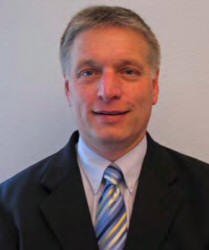 |
|
Scientific Detectors for Astronomy
Dr. Jamese Beletic
Tuesday, August 26, 2008 6:30 PM
Co-Sponsored with IEEE Buenaventura EDCAS
Note Location: Skyworks Solutions, Newbury Park
An astronomical facility can be simplistically divided into two main parts: (1) the telescope that collects the light and, (2) an instrument that measures the light. Perhaps the most important part of the instrument is the detector that senses the light. The performance of the telescope-instrument system is directly a function of the performance of the detector: an instrument with an outstanding detector on a 4-meter telescope can outperform an instrument with a poor detector on an 8-meter telescope. Thus, it is critical for every telescope to have the best detectors possible.
This presentation will present a broad overview of the scientific detectors that are used at major astronomical observatories. The talk will concentrate on the types of detectors that are produced by Teledyne Imaging Sensors: CMOS-based imaging sensors that are used for detection of ultraviolet, visible and infrared wavelengths. The content of this seminar is targeted toward those who are not detector specialists, but seek a basic understanding of the fundamental physics and architecture of optical and infrared detectors.
Dr. James Beletic
Director of Astronomy and Civil Space, Teledyne Imaging Sensors
 James W. Beletic has over 25 years experience in visible and infrared focal planes. He received a Ph.D. in Applied Physics from Harvard University and has held leadership positions at major research centers in the United States and Europe, including MIT Lincoln Laboratory, Georgia Institute of Technology, the European Southern Observatory and the W.M. Keck Observatory. He has developed new types of detector designs and his research groups have produced detector systems that have been used on 23 telescopes at 16 observatories in the United States, Hawaii, Chile and the Canary Islands. Dr. Beletic is currently the Director of Astronomy and Civil Space at Teledyne Imaging Sensors. James W. Beletic has over 25 years experience in visible and infrared focal planes. He received a Ph.D. in Applied Physics from Harvard University and has held leadership positions at major research centers in the United States and Europe, including MIT Lincoln Laboratory, Georgia Institute of Technology, the European Southern Observatory and the W.M. Keck Observatory. He has developed new types of detector designs and his research groups have produced detector systems that have been used on 23 telescopes at 16 observatories in the United States, Hawaii, Chile and the Canary Islands. Dr. Beletic is currently the Director of Astronomy and Civil Space at Teledyne Imaging Sensors.
|
| Meeting Site: |
California Lutheran University Gilbert Sports and Fitness Center,
Second Floor, rooms 253/254, 130 Overton Court, Thousand Oaks, CA.
Meetings are free, and open to the public
|
| Dinner: |
Available at 6 p.m. for $12 payable at the door, no RSVP needed. |
| Parking: |
Parking is free outside of the Gilbert Sports Center |
| Contact: |
Steve Johnson, sfjohnso@ieee.org |
| Our Sponsors: |
La Reina High School and Middle School,
California Lutheran University,
IEEE EMB Society,
IEEE Buenaventura Section, |
|

 James W. Beletic has over 25 years experience in visible and infrared focal planes. He received a Ph.D. in Applied Physics from Harvard University and has held leadership positions at major research centers in the United States and Europe, including MIT Lincoln Laboratory, Georgia Institute of Technology, the European Southern Observatory and the W.M. Keck Observatory. He has developed new types of detector designs and his research groups have produced detector systems that have been used on 23 telescopes at 16 observatories in the United States, Hawaii, Chile and the Canary Islands. Dr. Beletic is currently the Director of Astronomy and Civil Space at Teledyne Imaging Sensors.
James W. Beletic has over 25 years experience in visible and infrared focal planes. He received a Ph.D. in Applied Physics from Harvard University and has held leadership positions at major research centers in the United States and Europe, including MIT Lincoln Laboratory, Georgia Institute of Technology, the European Southern Observatory and the W.M. Keck Observatory. He has developed new types of detector designs and his research groups have produced detector systems that have been used on 23 telescopes at 16 observatories in the United States, Hawaii, Chile and the Canary Islands. Dr. Beletic is currently the Director of Astronomy and Civil Space at Teledyne Imaging Sensors.